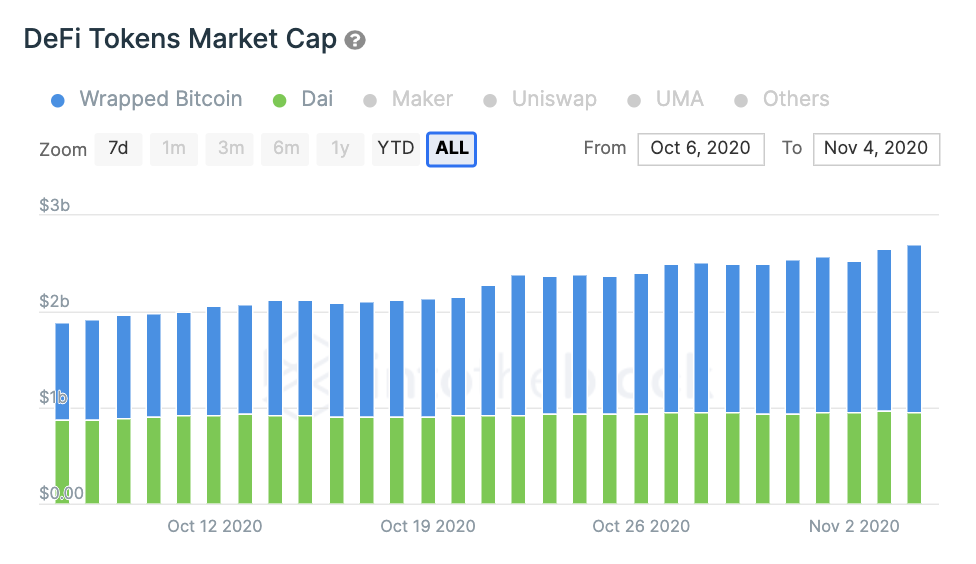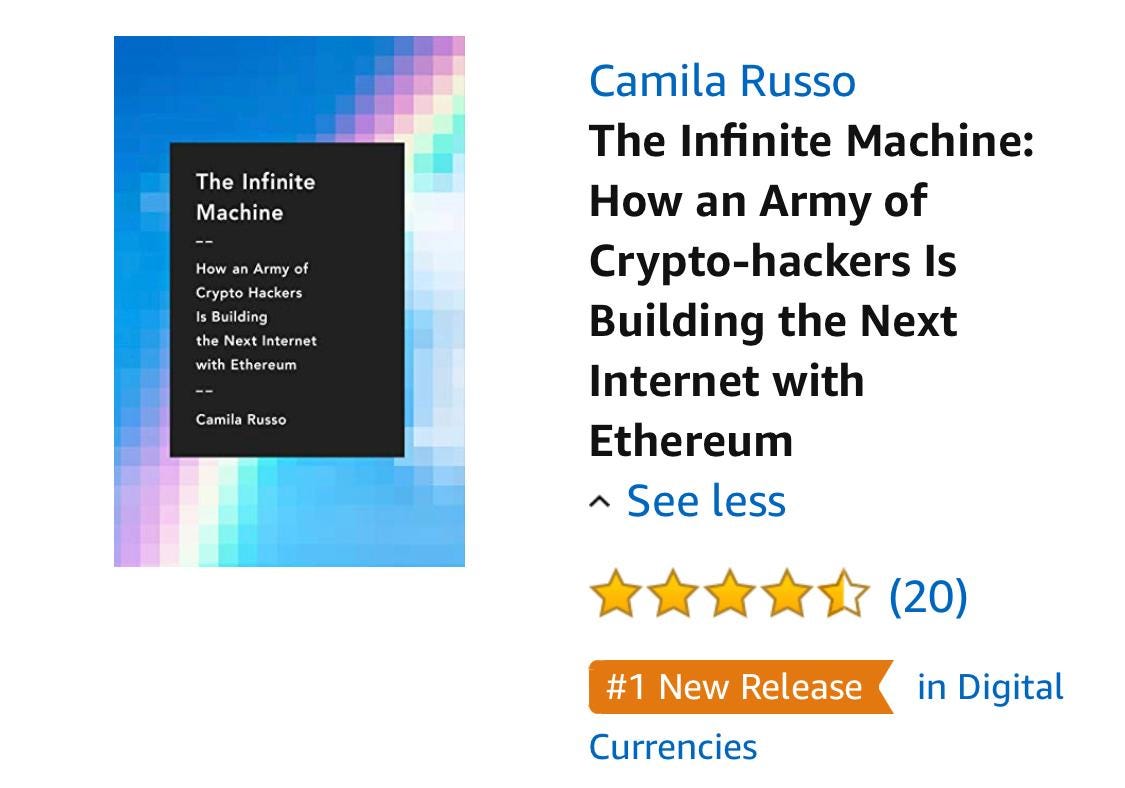It's Risk-On Again and DeFi Knows It
DeFi tokens rebound, but the underlying protocol metrics never fell.
Hello Defiers! It’s a sunny day in New York today and it seems like the cloud of election uncertainty is clearing up as well. Subsiding uncertainty often means one thing for traders: it’s risk-on again. Bitcoin smashed through $15k, ETH is comfortably above $400, and DeFi tokens are rebounding. In today’s issue, we’re focusing on the fundamentals underpinning this DeFi rebound, because as governance tokens sank in the fall, the actual protocols continued growing.
Image source: Trading View
The open economy is taking over the old one. Subscribe to keep up with this revolution. Click here to pay with DAI (for $100/yr) or sub with fiat by clicking on the button below ($10/mo, $100/yr).
🎙Listen to this week’s podcast w/ Lil Miquela creator Trevor McFedries:
🙌 Together with Zerion, a simple interface to access and use decentralized finance, Sorare, a fantasy football game with officially licensed cards on Ethereum, and Near, a high-performance proof-of-stake blockchain that interoperates with Ethereum.
On-Chain Markets Update by IntoTheBlock
DeFi Rebounds as Metrics Remained Strong in Selloff
DeFi tokens are rebounding after a slump in October amid increased coronavirus cases and election uncertainty, dragging down most financial assets.
All of the major DeFi tokens are up today, enough to erase each of their losses in the past week. 0x’s ZRX and Uniswap’s UNI are the biggest gainers, both up more than 10% so far this month. In the past three months, DeFi tokens are still down between 30% and 30% in the case of ZRX, UNI and MKR, and between 80% and 60% in the case if UMA, YFI and COMP.
The stark contrast between DeFi tokens’ summer performance and the one seen in the fall denoted a change in positioning from investors due to macroeconomic risks. When it comes specifically to crypto and DeFi, traders rotated out of governance tokens into less volatile assets such as stablecoins and Bitcoin. This led DeFi tokens to capitulate, with most of them reaching their lowest levels in 3-6 months.
But DeFi protocol’s key metrics continued to grow, sustaining high levels seen prior to their tokens crashing. Still strong fundamentals may be supporting the rebound.
Here are some key insights covering the recent DeFi token crash versus their protocols’ network activity:
1. DeFi Governance Tokens Plummet to Lowest Levels in Months
Source: IntoTheBlock’s DeFi insights
The market capitalization of DeFi governance tokens receded to under $5 billion on the day after the U.S. elections. This marks a 3-month low, retracing over 40% from their August highs.
2. WBTC & DAI Continue To Grow
At the same time, stablecoins and tokenized versions of Bitcoin continue to grow in market cap. In the case of wrapped Bitcoin and other versions of Bitcoin on Ethereum, they have grown both in terms of supply and price, making their growth significantly larger.
Source: IntoTheBlock’s DeFi insights
WBTC’s market cap has increased by 75% in the last month alone, in comparison to BTC’s 30% growth. Meanwhile, DAI’s market cap increased by approximately 10%. The diverging paths of these two assets in comparison to governance tokens points to a shift to a risk-off environment as traders rotated into less volatile but still potentially yield-generating assets.
In other words, as DeFi governance tokens slumped, there was a reallocation in the assets provided to DeFi protocols. Stablecoins and tokenized Bitcoin have been the main beneficiaries of this trend, as holders are still able to earn interest on top of them in DeFi protocols without the downside volatility recently experienced by DeFi tokens.
3. Bluechip Protocols’ Demand & Supply-Side Metrics Continue to Grow
The growth of stablecoins and tokenized Bitcoin has managed to offset the decrease in value caused by the slump in DeFi tokens. As such, key on-chain metrics for bluechip DeFi protocols have stayed resilient.
For instance, the lending protocol Compound reached a new all-time high for the liquidity supplied by its users. At the time of writing, over $2.6 billion is deposited into Compound by users who are generating yield on their deposits.
Source: IntoTheBlock’s DeFi insights
The $2.6 billion in liquidity provided makes Compound the second protocol in terms of supply provided by users, just behind Uniswap. This is not reflected in Compound’s TVL as the value locked formula subtracts the amount borrowed by users, which has also been increasing.
As can be seen in the right graph above, demand for loans in Compound continues to grow at a healthy pace. Despite COMP’s price dropping 25% between October 6 and November 5, the amount of loans borrowed has grown by 45% while its liquidity supply managed to increase by 74% over the same period.
Similarly, Uniswap has been able to sustain its key metrics at a high level. Trading volume and fees for the decentralized exchange (DEX) have been on a downward trend, but are still significantly higher than they were in August, when volumes only surpassed $200 million in a couple of days.
Source: IntoTheBlock’s DeFi insights
There was an outlier on October 26, when a spike of over $2 billion was related to flash loans used in Harvest Finance’s exploit. While this day was very profitable for liquidity providers who earned $6.6 million in fees, volume continued to drop slightly and is down 15% over the last 30 days.
The decreasing fees, however, have not stopped users from supplying increasing amounts of liquidity to Uniswap. Over the last 30 days, liquidity supplied to Uniswap has grown by 21%. During the same period, Uniswap’s governance token UNI dropped more than 30%.
Overall, governance tokens have not moved in tandem with protocol fundamentals over the last few months. As the macro environment shifted into a risk-off environment, DeFi tokens crashed as traders rotated into more stable assets. At the same time, this has not stopped bluechip DeFi protocols like Compound and Uniswap from growing or at least sustaining high levels in key demand- and supply-side metrics.
With the US elections’ results coming into conclusion, risk assets such as DeFi tokens appear to be recovering. Will token prices catch up to protocols’ growing fundamentals? Or is the DeFi bear market not over yet?
1inch Upgrades DEX Aggregator
DEX Aggregator 1inch has introduced its v2, which contains a new discovery and routing algorithm to execute swaps faster and at better rates. The team also improved the user interface design.
Swaps are split across 21 liquidity protocols, including Uniswap v1 and v2, Balancer, Curve, Kyber, SushiSwap, DODO, Oasis and Mooniswap. 1inch can pack, unpack and migrate collateral tokens from Aave and Compound as part of the swap path.
$1M Locked in Percent Finance Due to Bug
A total of ~$970k in USDC, WBTC ad ETH is locked in Percent Finance, a Compound Finance fork, due to an error in its interest rate model update. Users cannot supply, borrow, repay or withdraw from those markets. The team is urging users to repay any outstanding loans and withdraw in available markets.
Percent has reached out to USDC issuers Circle and Coinbase, and WBTC issuer BitGo, to help release those funds. Locked ETH appears to be “irretrievable, but we are currently working on potential scenarios to make affected users whole,” according to a post by the team.
Vitalik Buterin Commits $1.5M for Staking on Eth2: Decrypt
Vitalik Buterin, co-founder of Ethereum, has sent around 3,200 ETH, worth $1.5 million, to the platform’s newly established deposit contract in preparation for staking.
The Defiant is a daily newsletter focusing on decentralized finance, a new financial system that’s being built on top of open blockchains. The space is evolving at breakneck speed and revolutionizing tech and money. Sign up to learn more and keep up on the latest, most interesting developments. Subscribers get full access at $10/month or $100/year, while free signups get only part of the content.
About the founder and editor: Camila Russo is the author of The Infinite Machine, the first book on the history of Ethereum, and was previously a Bloomberg News markets reporter based in New York, Madrid and Buenos Aires. She has extensively covered crypto and finance, and now is diving into DeFi, the intersection of the two.












